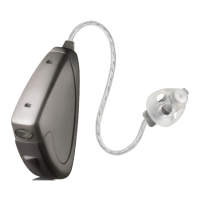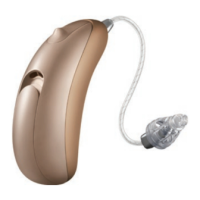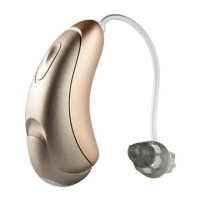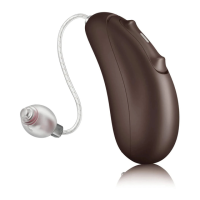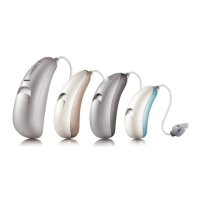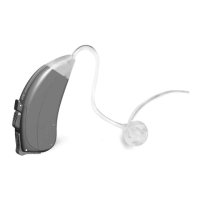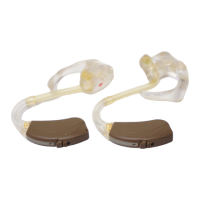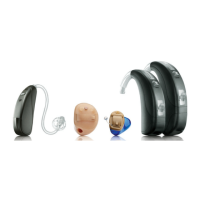Do you have a question about the Unitron Moxi V-R and is the answer not in the manual?
How to charge your hearing aids for the first time and check status.
Explanation of the hearing aid's multi-function button and indicator light.
Instructions on how to switch the hearing aid on and off.
How to use tap control for device functions.
Diagram and labels for Moxi V-R hearing aids.
Diagram and labels for Moxi V-RT hearing aids.
Illustrations of available earpiece options.
Information about the external power supply for the charger.
Technical specifications for the power supply.
Step-by-step guide to connect the charger to a power source.
Location of serial number and year of manufacture.
Procedure to turn the hearing aid on.
Procedure to turn the hearing aid off.
Steps for initial Bluetooth pairing with a device.
How hearing aids automatically connect to a paired phone.
Guide on how to make a phone call using hearing aids.
Steps to enable flight mode on the hearing aid.
Steps to disable flight mode and exit.
Information on phone compatibility for the app.
Guide on using the telecoil function in public places.
Information on the expected lifespan of the hearing aids and charger.
Details on the service period for repairs and maintenance.
Daily cleaning and maintenance for the hearing aid.
Daily cleaning and maintenance for the charger.
Weekly cleaning and maintenance for the hearing aid.
Weekly cleaning and maintenance for the chargers.
Steps to remove the earpiece or dome from the speaker.
Information on local warranty terms.
Details of the international warranty coverage.
Statement of conformity with regulations.
Compliance information for Australia and New Zealand.
Explanation of CE marking and regulatory compliance.
Symbols related to manufacturer, date, and serial numbers.
Symbols indicating important user information and warnings.
Symbols for FCC, Bluetooth, Prescription Device, etc.
Symbols for water/dust resistance and disposal.
Symbols specific to European power supply units.
Solutions for hearing aids that do not power on.
Steps to resolve issues with no sound from the hearing aid.
Troubleshooting for short battery life.
Solutions for insufficient volume.
Troubleshooting steps for whistling sounds.
Solutions for distorted or unclear audio.
Fixing issues with earpieces falling out.
Solutions for not hearing phone calls.
Steps to resolve charging failures.
Tips for improving telephone reception.
Who the hearing aids are intended for.
General clinical indications for hearing aid use.
General clinical contraindications for hearing aid use.
Benefits of hearing aids for speech understanding.
Benefits of the tinnitus feature for distraction.
Common side effects of hearing aids.
Warnings related to battery, flight mode, and modifications.
Safety advice for children and users with implants.
Warnings regarding interference and equipment stacking.
Safety distance for RF devices.
Warnings about ear canal and physical impacts.
Warnings about magnets, batteries, and charger contacts.
Warnings about electrical hazards and charger requirements.
Critical warnings about lithium button/coin batteries.
Recommendations for product care and safety.
Advice on handling, storage, and protecting from shocks.
Precautions for medical examinations like X-ray and MRI.
How hearing aid performance can vary with mobile phones.
Warnings and principles related to the tinnitus masker.
Guidelines for using the tinnitus masker as prescribed.
How to charge your hearing aids for the first time and check status.
Explanation of the hearing aid's multi-function button and indicator light.
Instructions on how to switch the hearing aid on and off.
How to use tap control for device functions.
Diagram and labels for Moxi V-R hearing aids.
Diagram and labels for Moxi V-RT hearing aids.
Illustrations of available earpiece options.
Information about the external power supply for the charger.
Technical specifications for the power supply.
Step-by-step guide to connect the charger to a power source.
Location of serial number and year of manufacture.
Procedure to turn the hearing aid on.
Procedure to turn the hearing aid off.
Steps for initial Bluetooth pairing with a device.
How hearing aids automatically connect to a paired phone.
Guide on how to make a phone call using hearing aids.
Steps to enable flight mode on the hearing aid.
Steps to disable flight mode and exit.
Information on phone compatibility for the app.
Guide on using the telecoil function in public places.
Information on the expected lifespan of the hearing aids and charger.
Details on the service period for repairs and maintenance.
Daily cleaning and maintenance for the hearing aid.
Daily cleaning and maintenance for the charger.
Weekly cleaning and maintenance for the hearing aid.
Weekly cleaning and maintenance for the chargers.
Steps to remove the earpiece or dome from the speaker.
Information on local warranty terms.
Details of the international warranty coverage.
Statement of conformity with regulations.
Compliance information for Australia and New Zealand.
Explanation of CE marking and regulatory compliance.
Symbols related to manufacturer, date, and serial numbers.
Symbols indicating important user information and warnings.
Symbols for FCC, Bluetooth, Prescription Device, etc.
Symbols for water/dust resistance and disposal.
Symbols specific to European power supply units.
Solutions for hearing aids that do not power on.
Steps to resolve issues with no sound from the hearing aid.
Troubleshooting for short battery life.
Solutions for insufficient volume.
Troubleshooting steps for whistling sounds.
Solutions for distorted or unclear audio.
Fixing issues with earpieces falling out.
Solutions for not hearing phone calls.
Steps to resolve charging failures.
Tips for improving telephone reception.
Who the hearing aids are intended for.
General clinical indications for hearing aid use.
General clinical contraindications for hearing aid use.
Benefits of hearing aids for speech understanding.
Benefits of the tinnitus feature for distraction.
Common side effects of hearing aids.
Warnings related to battery, flight mode, and modifications.
Safety advice for children and users with implants.
Warnings regarding interference and equipment stacking.
Safety distance for RF devices.
Warnings about ear canal and physical impacts.
Warnings about magnets, batteries, and charger contacts.
Warnings about electrical hazards and charger requirements.
Critical warnings about lithium button/coin batteries.
Recommendations for product care and safety.
Advice on handling, storage, and protecting from shocks.
Precautions for medical examinations like X-ray and MRI.
How hearing aid performance can vary with mobile phones.
Warnings and principles related to the tinnitus masker.
Guidelines for using the tinnitus masker as prescribed.
| Category | Hearing Aid |
|---|---|
| Manufacturer | Unitron |
| Model | Moxi V-R |
| Style | Receiver-in-canal (RIC) |
| Type | Digital |
| Rechargeable | Yes |
| Battery Type | Lithium-ion |
| Battery Life | Up to 24 hours |
| IP Rating | IP68 |
| Channels | 16 |
| Wireless Connectivity | Bluetooth |
| Compatibility | iOS and Android devices |
| Noise Reduction | Yes |
| Feedback Management | Yes |
| Frequency Range | Reportedly up to 10 kHz |

